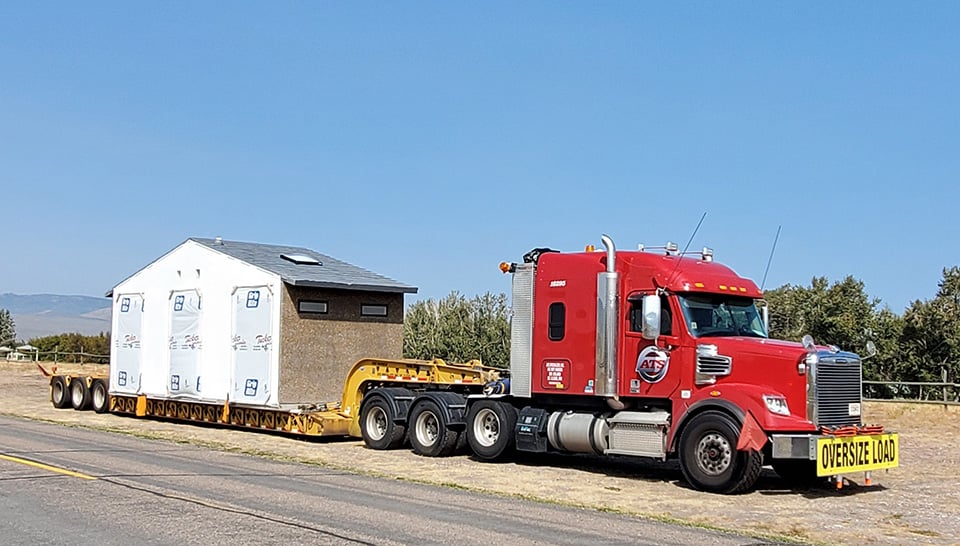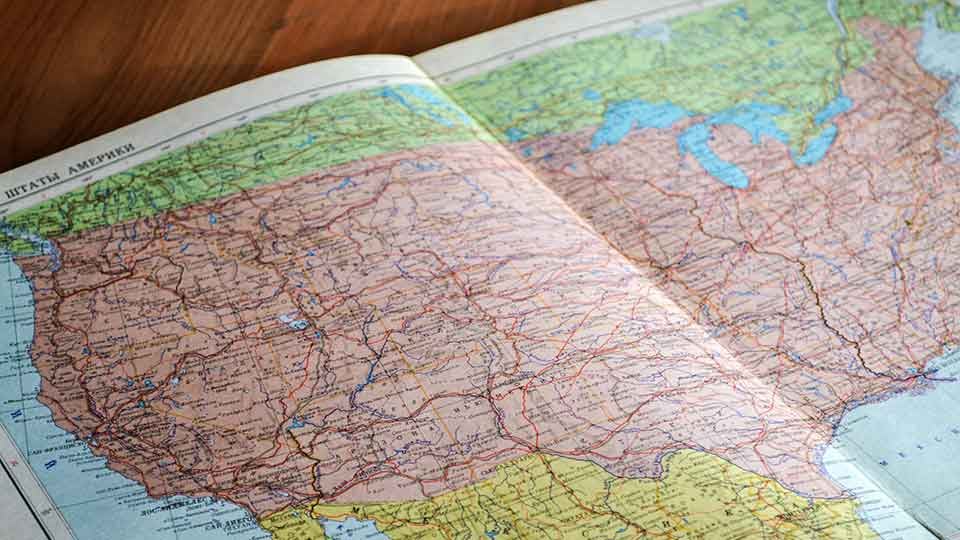Every shipment takes planning and coordination to get from A to B. Shipping open-deck freight is uniquely challenging — especially when load dimensions edge into the oversized realm.
Oversize shipments — whether in dimension or weight — are more difficult to route and find reliable capacity for. These shipments are also more expensive to move than legal loads.
For these reasons, you can’t be caught off guard when a commodity qualifies as “oversize” and requires permits, approvals and additional oversight to move. Your company can’t afford to encounter delays due to confusion about freight thresholds and restrictions.
Unfortunately, oversize/overweight (OSOW) transport restrictions vary from one location to another. Each state sets its own OSOW freight transport regulations, making it hard to know exactly whether yours can transit permit-free or not.
Here at Anderson Trucking Service (ATS), our in-house permit team has an intimate knowledge of each state’s OSOW travel laws and restrictions. After decades in this business, we’ve seen how impactful these restrictions can become on the supply chains of shippers who don’t anticipate them.

To ensure you’re properly equipped to recognize when your shipment qualifies as “too tall” for transport, this article will explain the (general) legal freight height restrictions per state, how this changes in states located east and west of the Mississippi River and why this discrepancy exists.
Legal Freight Height West of the Mississippi River
Generally speaking (with a couple of exceptions) shipments can be taller west of the Mississippi River than they are in the East. Below, we’ve included the legal maximum loaded height for these states.
- Alaska (AK): 14 feet
- Arizona (AZ): 14 feet
- Arkansas (AR): 14 feet
- California (CA): 14 feet
- Colorado (CO): 14 feet 6 inches
- Hawaii (HI): 14 feet
- Idaho (ID): 14 feet
- Iowa (IA): 13 feet 6 inches
- Kansas (KS): 14 feet
- Louisiana (LA): 13 feet, 6 inches (14 feet if operating exclusively on interstate highways)
- Minnesota (MN): 13 feet 6 inches
- Missouri (MO): 14 feet
- Montana (MT): 14 feet
- Nebraska (NE): 14 feet 6 inches
- Nevada (NV): 14 feet
- New Mexico (NM): 14 feet
- North Dakota (ND): 14 feet
- Oklahoma (OK): 14 feet
- Oregon (OR): 14 feet
- South Dakota (SD): 14 feet
- Texas (TX): 14 feet
- Utah (UT): 14 feet
- Washington (WA): 14 feet
- Wyoming (WY): 14 feet

Legal Freight Height East of the Mississippi
East of the Mississippi River, freight height limits are more standard. Most of these states have a maximum legal height of 13 feet, 6 inches.
- Alabama (AL): 13 feet, 6 inches
- Connecticut (CT): 13 feet 6 inches
- Delaware (DE): 13 feet 6 inches
- Florida (FL): 13 feet 6 inches
- Georgia (GA): 13 feet 6 inches
- Illinois (IL): 13 feet, 6 inches
- Indiana (IN): 13 feet, 6 inches
- Kentucky (KY): 13 feet, 6 inches
- Maine (ME): 14 feet (13 feet, 6 inches on Maine Turnpike)
- Maryland (MD): 13 feet, 6 inches
- Massachusetts (MA): 13 feet, 6 inches
- Michigan (MI): 13 feet, 6 inches
- Mississippi (MS): 13 feet, 6 inches
- New Hampshire (NH): 13 feet, 6 inches
- New Jersey (NJ): 13 feet, 6 inches
- New York (NY): 13 feet, 6 inches
- North Carolina (NC): 13 feet, 6 inches
- Ohio (OH): 13 feet, 6 inches
- Pennsylvania (PA): 13 feet, 6 inches
- Rhode Island (RI): 13 feet, 6 inches
- South Carolina (SC): 13 feet, 6 inches
- Tennessee (TE): 13 feet, 6 inches
- Vermont (VT): 13 feet, 6 inches
- Virginia (VA): 13 feet, 6 inches
- West Virginia (WV): 13 feet, 6 inches
- Wisconsin (WI): 13 feet, 6 inches
Why Do Legal Freight Height Limits Vary Between States?
Legal freight height limits vary between states for a number of reasons, including:
- The area east of the Mississippi was colonized earlier. When infrastructure, including roads and bridges, was built in this area, they were accommodating the vehicles of the time — and using the construction equipment they had available, which was significantly smaller than what currently exists.
As settlers moved west and population centers sprang up west of the Mississippi, infrastructure was built to accommodate newer, larger vehicles and cargo. - Taller legal load limits also loosely correspond with lower-population states. Densely populated areas often have tighter over-dimensional travel restrictions, as there are more potential hazards that make it more difficult for overheight freight to travel.
More populated states also tend to have tighter restrictions for safety and environmental concerns. This can also contribute to lower legal height limits. - Eastern states tend to be geographically smaller, meaning you are more likely to travel through several states in one day. A universal limit makes shipping less complicated.
No matter where you are traveling, knowing the exact dimensions of your freight is critical.
How Do You Measure Freight Height?
Freight height is measured from the ground to the tallest point of the load. The measurement includes the freight itself, any pallet or platform it is sitting on, trailer and tires.
Height is a critical measurement — a discrepancy of just a few inches could mean failure to clear a bridge. This is not the place to use an estimate or to decide that it’s “good enough.”
You can quickly measure the freight height by hooking a tape measure to the highest level of the load and then reaching the tape measure to the ground. Taking time to accurately measure your freight is a critical step toward success.
- If there is any doubt about the highest point of the load, measure more than one high point.
- Measure on level ground. You need an accurate measurement to the highest point of the freight.
- Don’t rely on specifications. Measure the loaded truck and trailer before the driver leaves the point of origin.
Freight height, length, width and weight are all critical to your shipment. Inaccuracies could mean fees and delays, or collisions or accidents that harm the freight, truck, infrastructure or people.
What Can You Do if Your Freight Is Overheight?
Once you know the legal limits in every state your freight will be passing through, it’s time to prepare your freight. While you may not be able to ship your cargo on a standard flatbed, there are alternatives available for over-tall freight.
Divide Your Freight
While it isn’t always possible to change the height of your freight, in some cases you can lower a crane, disassemble machinery or divide your freight into multiple shipments. If this is a possibility, it’s legally required and may be the easiest option for hauling an overheight load.
Stacked freight consisting of one or more units stacked on top of one another is considered divisible freight. Divisible freight cannot be permitted as OSOW and must be split onto multiple vehicles for transit.
Change Your Trailer Type
A standard flatbed trailer is 5 feet high. Freight up to 8 feet, 6 inches tall can be transported through any state via standard flatbed. Some freight, like shipping containers, are specially designed to meet legal load limits on a flatbed.
Freight taller than 8 feet, 6 inches requires a more specialized type of trailer:
- Step-deck trailers have clearance of 3 feet, 6 inches
- Double-drop or lowboy trailers are usually 24 inches
- RGN or removable gooseneck trailers have 24-inch clearance. These are considered specialty equipment and will come with a higher cost per mile.
- Perimeter trailers hold freight 18 inches above the ground. Perimeter trailers are heavy haul equipment designed for freight that is overheight and overwidth, such as data centers. Perimeter trailers are highly specialized and will cost several dollars per mile over the standard flatbed cost, plus the cost of required escort vehicles.
When specifying overheight freight, talk with your provider to be sure they have the type of trailer you need to safely and legally move your load.
Permitted Freight
Cargo that is over-dimensional in height, length, width or weight is considered oversize and can be transported with a permit.
Over-dimensional freight requires a separate permit for each jurisdiction, whether that be state, county or township. When specifying an oversize load, make sure you or your provider are properly planning the route the freight will travel, and make sure you have appropriate permits in every jurisdiction. Failing to properly plan for a permitted load can lead to delays and fees.
Especially when dealing with height (bridges and power lines can’t be moved), route planning is essential for OSOW freight. The driver may have to take secondary roads in some areas to avoid hazards. A route engineer will provide a complete plan to make sure the load arrives safely.
Note that in many jurisdictions, a load will not be permitted as oversize on a standard flatbed when a lower-profile trailer is available. The expectation is that the smaller trailer will be specified, rather than the full-height flatbed.
Over-dimensional permits are for freight up to a specific size. For height, this is usually 17 feet. Larger than that is considered heavy haul freight. If your load cannot be made shorter than 17 feet when loaded on a trailer, make sure your broker or carrier provides heavy haul services.
Transit Via Water
Especially in urban areas along the east coast, there may not be a way to legally truck your freight. Often, this means the shipment travels the majority of the distance via barge and then is transloaded to a truck for the final leg of shipment.
Dealing with overheight freight is often inconvenient and comes with additional costs. But the consequences of not planning ahead and properly planning for the freight can be disastrous.
Know the Legal Transportation Height for All 50 States
Shipping oversize freight demands meticulous planning and a thorough understanding of local regulations. You can't afford to be caught off guard when your load is labeled "oversize" and needs permits and approvals to move.
It’s not enough to know the height limits at your destination and origin points. You are required to obtain an oversize freight permit for every state your freight will be traveling through, even if only for a few miles.
Learn more about safely transporting freight by subscribing to our Learning Hub, where we regularly post updates and topics about everything related to the trucking industry.
If you are preparing a load for interstate shipment, contact our experienced team at ATS for details.





